On Saturday, April 27, Berkeley Lab’s Physics Division hosted the 2024 ATLAS Masterclass for twenty-six high school students (juniors and seniors) interested in high-energy physics. The program included introductory lessons from volunteer postdocs and graduate students and hands-on analysis of real data from the ATLAS Experiment, located at the Large Hadron Collider (LHC) at CERN.
This masterclass series is hosted on a global scale by the International Particle Physics Outreach Group, with over 60 institutions participating annually. The event’s hybrid format enabled the Berkeley Lab team to include online participants from Animas High School in Durango, CO, along with a robust onsite program for students from the following Bay Area schools: Albany High School, Antioch High School, Berkeley High School, Bishop O’Dowd High School in Oakland, Campolindo High School in Moraga, Castro Valley High School, College Park High School in Pleasant Hill, De La Salle High School in Concord, Heritage High School in Brentwood, Mills High School in Millbrae, Mission San Jose High School in Fremont, Mountain House High School, Notre Dame High School in San Jose, and Pioneer High School in Woodland, CA. Berkeley Lab also partnered with TRIUMF, Canada’s particle accelerator center in Vancouver, to facilitate a combined data analysis presentation with student groups from other organizations across Canada and the U.S., enabling several hundred students to participate in the day’s program.
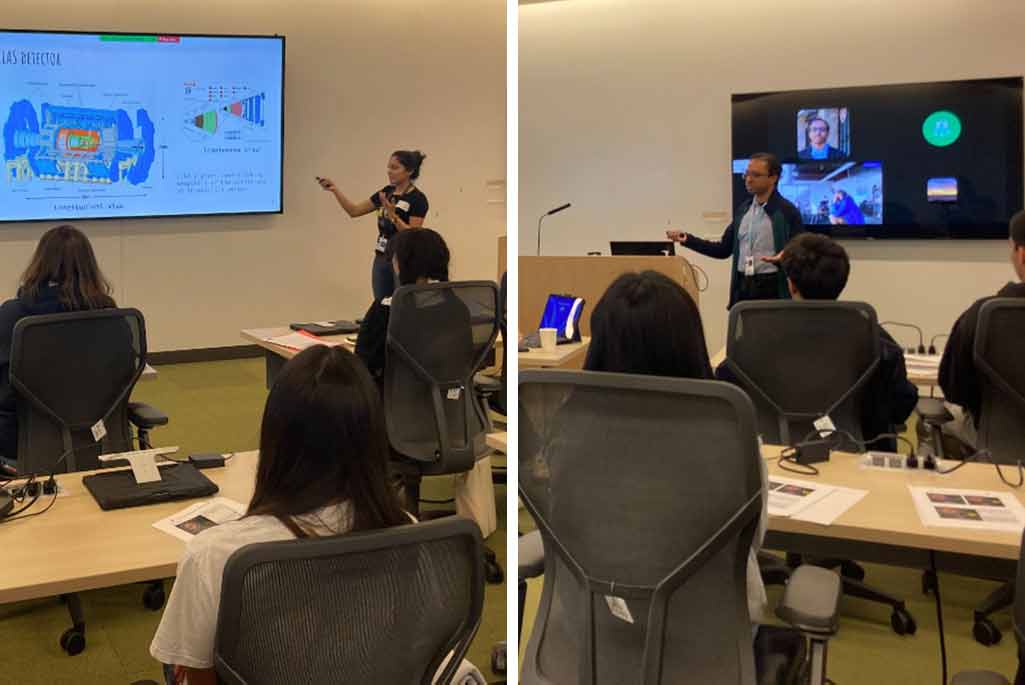 Class participants learned how to use HYPATIA (Hybrid Pupil’s Analysis Tool for Interactions in ATLAS), an educational software that enables users to analyze and display data using real ATLAS data from the CERN open-data initiative as well as the same event displays as those used by ATLAS physicists in the experiment. Interactive talks on particle physics and data analysis techniques were presented by Berkeley Lab postdocs Angira Rastogi and Beojan Stanislaus (pictured above, credit: Emily Thompson), and a team of seven ATLAS postdocs and graduate students then worked closely with each class participant on the data analysis, to help them select for collision remnants that showed evidence of head-on proton-proton collisions: the conditions necessary for producing particles of interest at the LHC.
Class participants learned how to use HYPATIA (Hybrid Pupil’s Analysis Tool for Interactions in ATLAS), an educational software that enables users to analyze and display data using real ATLAS data from the CERN open-data initiative as well as the same event displays as those used by ATLAS physicists in the experiment. Interactive talks on particle physics and data analysis techniques were presented by Berkeley Lab postdocs Angira Rastogi and Beojan Stanislaus (pictured above, credit: Emily Thompson), and a team of seven ATLAS postdocs and graduate students then worked closely with each class participant on the data analysis, to help them select for collision remnants that showed evidence of head-on proton-proton collisions: the conditions necessary for producing particles of interest at the LHC.
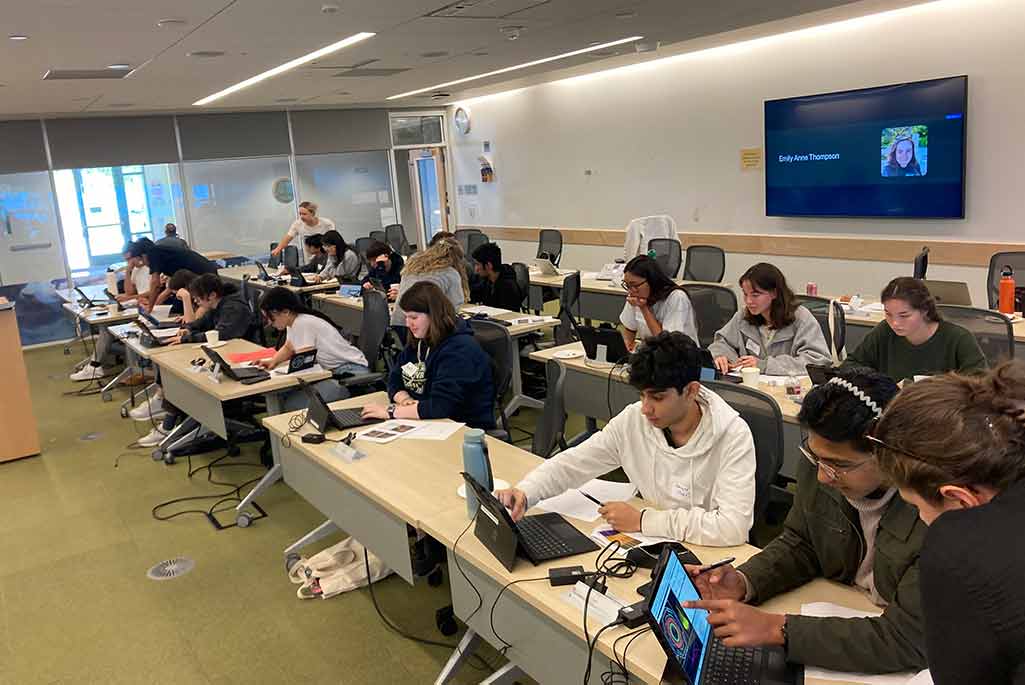 Each class participant worked on their own laptop to analyze 50 collision events from the dataset, approximately 1300 events overall. (Students at work in photo at right, credit: Rebecca Carney.) “Participants were keen to understand how to work with the real data in front of them,” said Laura Nosler, a UC Berkeley graduate student working with the ATLAS group at Berkeley Lab. “The focus of this masterclass training was to impart a sense of how this sort of science is actually done and for each participant to work at their own pace.”
Each class participant worked on their own laptop to analyze 50 collision events from the dataset, approximately 1300 events overall. (Students at work in photo at right, credit: Rebecca Carney.) “Participants were keen to understand how to work with the real data in front of them,” said Laura Nosler, a UC Berkeley graduate student working with the ATLAS group at Berkeley Lab. “The focus of this masterclass training was to impart a sense of how this sort of science is actually done and for each participant to work at their own pace.”
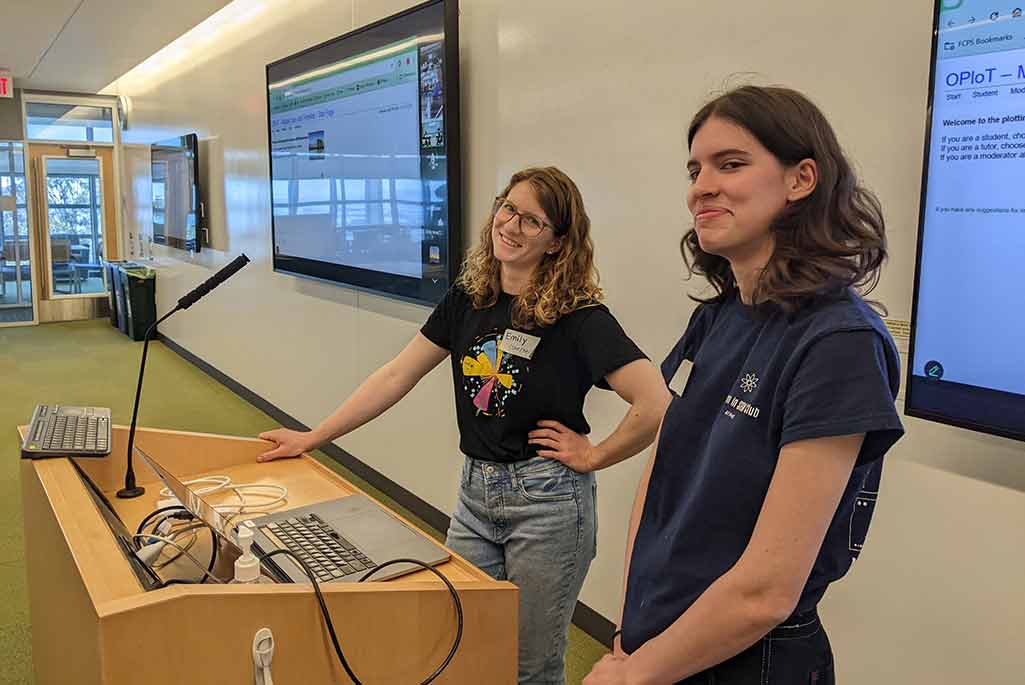 The combined analyses from all of the participating school groups were then presented by ATLAS postdoc Emily Thompson and high school visitor Elena Mora (pictured in photo at right, credit: Rebecca Carney) during a joint videoconference with TRIUMF and the other participating institutions. “This is the highlight of the event,” noted UC Berkeley postdoc Louis-Guillaume Gagnon, who coordinated the joint program. “Even with 1300 collision events, some decay channels – like the diphoton channel – do not show evidence of any interesting physics until the dataset is combined with the datasets of the other institutes from around the world. It’s a real “aha moment” to witness the Higgs resonance arise from the data during combination.”
The combined analyses from all of the participating school groups were then presented by ATLAS postdoc Emily Thompson and high school visitor Elena Mora (pictured in photo at right, credit: Rebecca Carney) during a joint videoconference with TRIUMF and the other participating institutions. “This is the highlight of the event,” noted UC Berkeley postdoc Louis-Guillaume Gagnon, who coordinated the joint program. “Even with 1300 collision events, some decay channels – like the diphoton channel – do not show evidence of any interesting physics until the dataset is combined with the datasets of the other institutes from around the world. It’s a real “aha moment” to witness the Higgs resonance arise from the data during combination.”
The Colorado students were invited by Liam Foster, a graduate student working with the ATLAS group at Berkeley Lab, who was excited to include students from his alma mater in the Berkeley Lab event. “I had a great high school experience in Durango, but extracurricular activities were limited in such a rural area, and I found it difficult to get involved in physics,” said Foster, who added that “being able to offer this kind of advanced program to those who would otherwise not have this type of opportunity is something I’m passionate about.“
“We want to make this program accessible to participants from a wide variety of socio-economic backgrounds,” said Anne Fortman, an ATLAS postdoc who led the application process. “Having a virtual option will hopefully lower the barrier to attend, and it’s something we plan to continue in future years.“
One of the highlights for the onsite participants was a luncheon with UC Berkeley graduate students working in STEM. Luc Le Pottier, a graduate student with Berkeley Lab’s ATLAS group who also engages in a significant amount of outreach work teaching physics to inmates at San Quentin correctional facilities, had this to say: “Giving the high school students an opportunity to speak about their career aspirations with graduate students only a few years their senior gave them a sense of what pursuing a future in STEM might look like, and what kinds of opportunities they might want to pursue on a path to graduate school.“
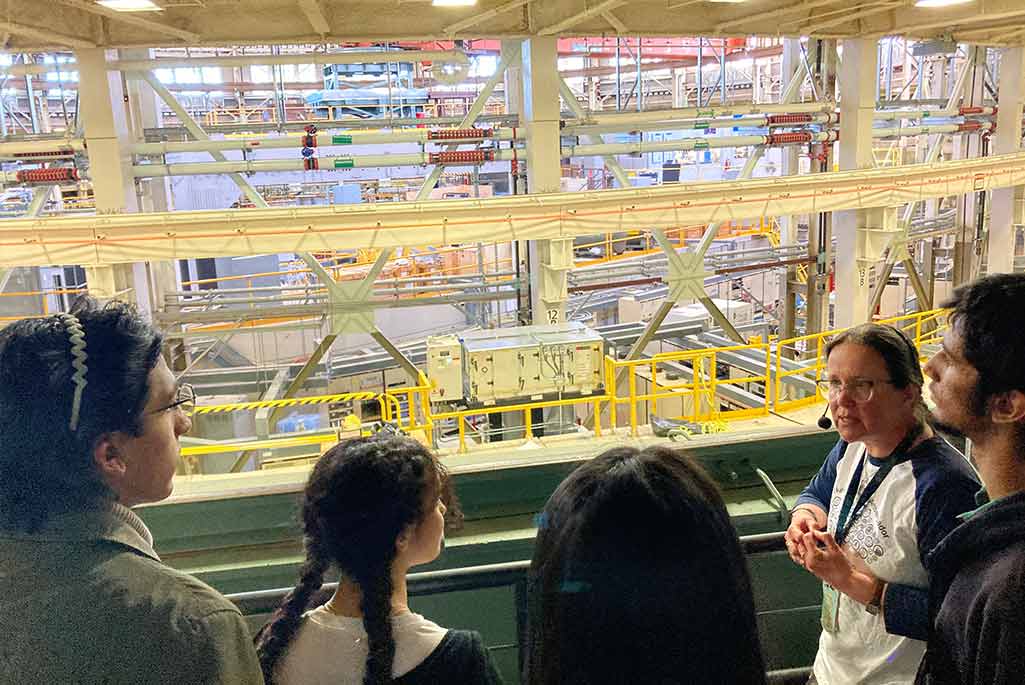 The onsite program concluded with a tour of the ALS led by Ina Reichel (in photo right, credit: Rebecca Carney), the Education, Outreach, & Diversity Coordinator for Berkeley Lab’s ATAP Division and member of the ALS Communications Group, who highlighted the differences between the LHC synchrotron and the Berkeley Lab user facility: “At the LHC, synchrotron radiation is a “nuisance” whereas at the ALS, it’s the “product.” Showing students an in-situ particle accelerator, especially at the birthplace of the cyclotron, really rounded out the day.”
The onsite program concluded with a tour of the ALS led by Ina Reichel (in photo right, credit: Rebecca Carney), the Education, Outreach, & Diversity Coordinator for Berkeley Lab’s ATAP Division and member of the ALS Communications Group, who highlighted the differences between the LHC synchrotron and the Berkeley Lab user facility: “At the LHC, synchrotron radiation is a “nuisance” whereas at the ALS, it’s the “product.” Showing students an in-situ particle accelerator, especially at the birthplace of the cyclotron, really rounded out the day.”
Rebecca Carney of Berkeley Lab’s Engineering Division, who received her master’s and Ph.D. degrees as a student on the ATLAS experiment and currently plays a leading role in detector development for CMB-S4, was the lead organizer for Berkeley Lab. “I’m especially grateful to the team of volunteers who presented talks, tutored students, and helped organize and host the event,” said Carney. She also extends the team’s special thanks to Physics Division Administrator Adam Foote, who kept the program running smoothly, and to Faith Dukes, who leads Berkeley Lab’s K-12 STEM Education and Outreach Program. “The K-12 team has spent the last six years building a trusted relationship with schools and STEM clubs in the Bay Area, and their support was invaluable to this event’s success.”
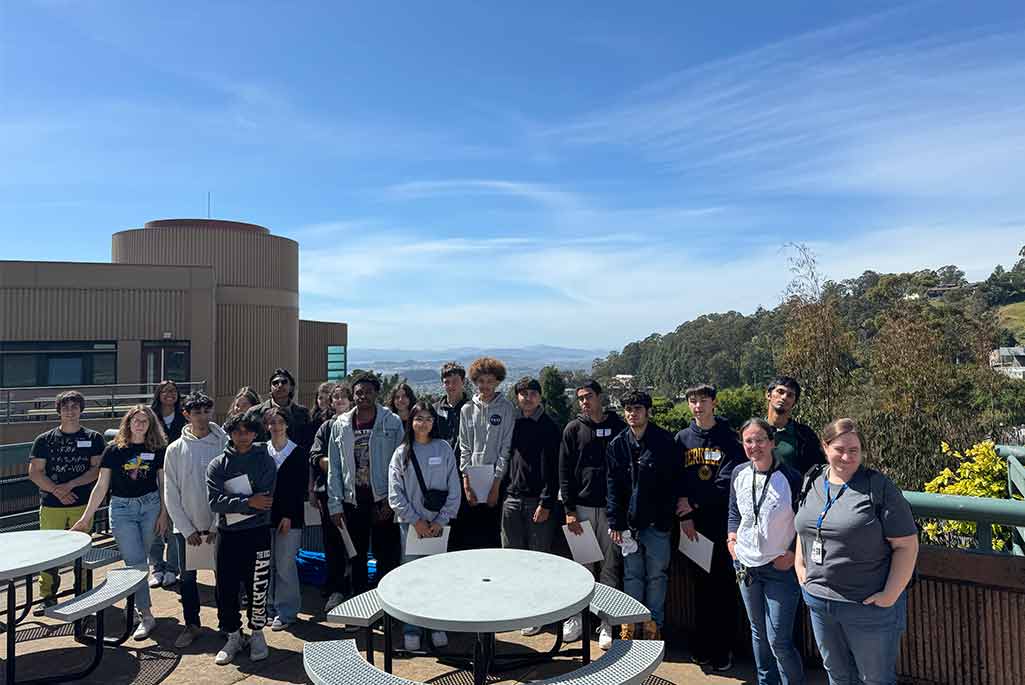
Students and instructors gathered for a group photo on the ALS terrace.
(Photo credit: Adam Foote)